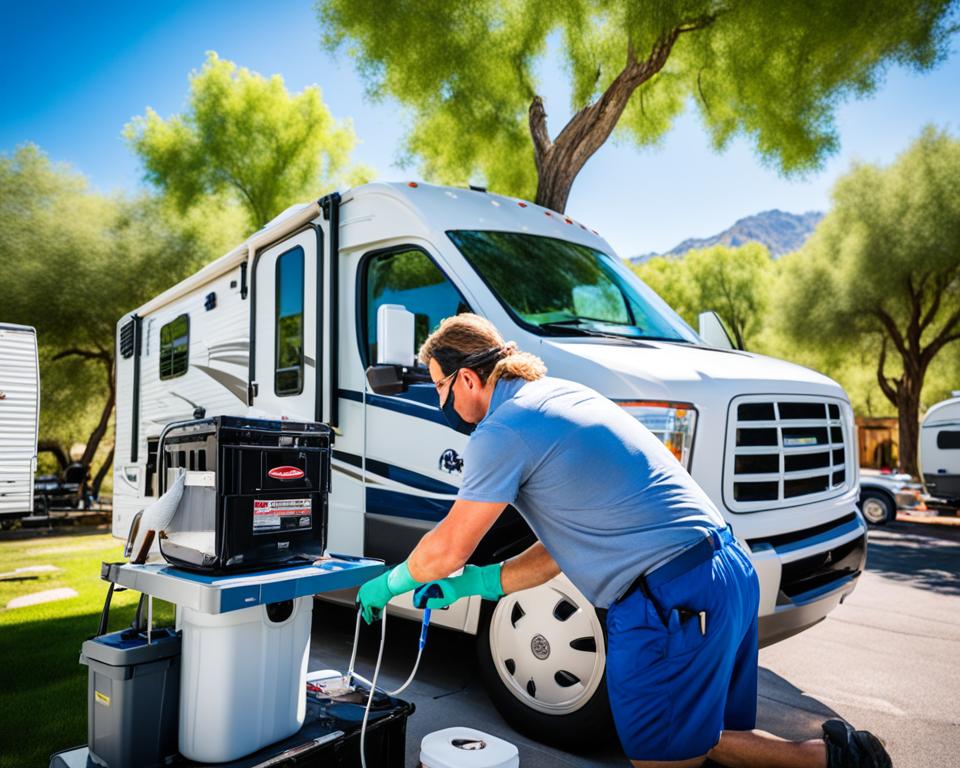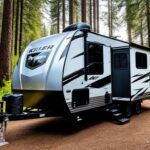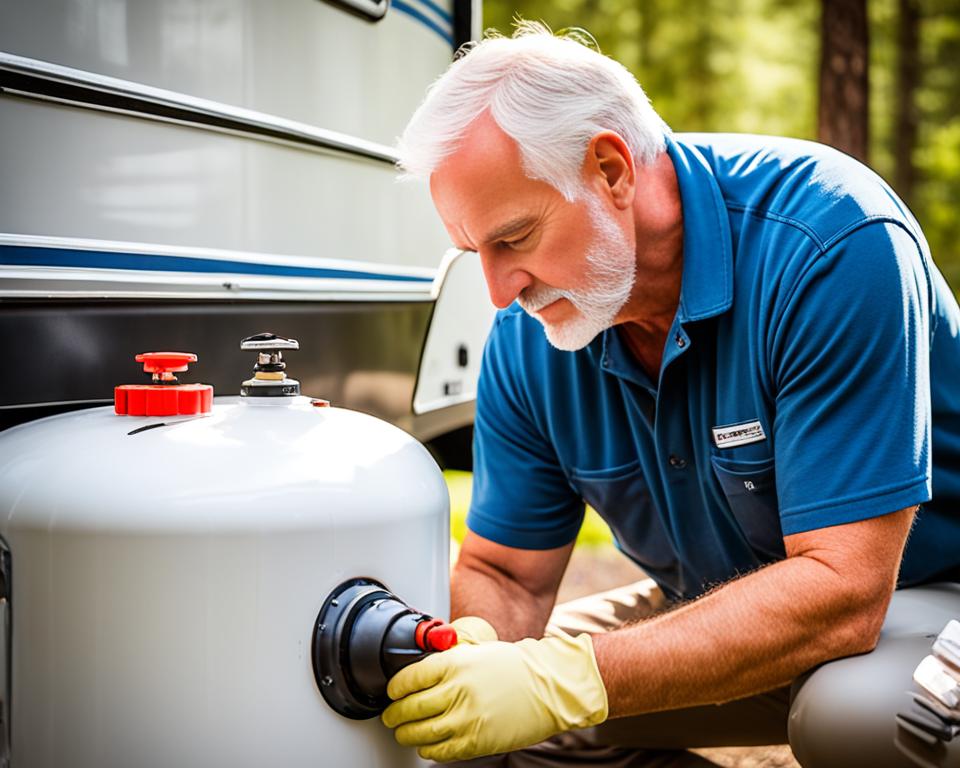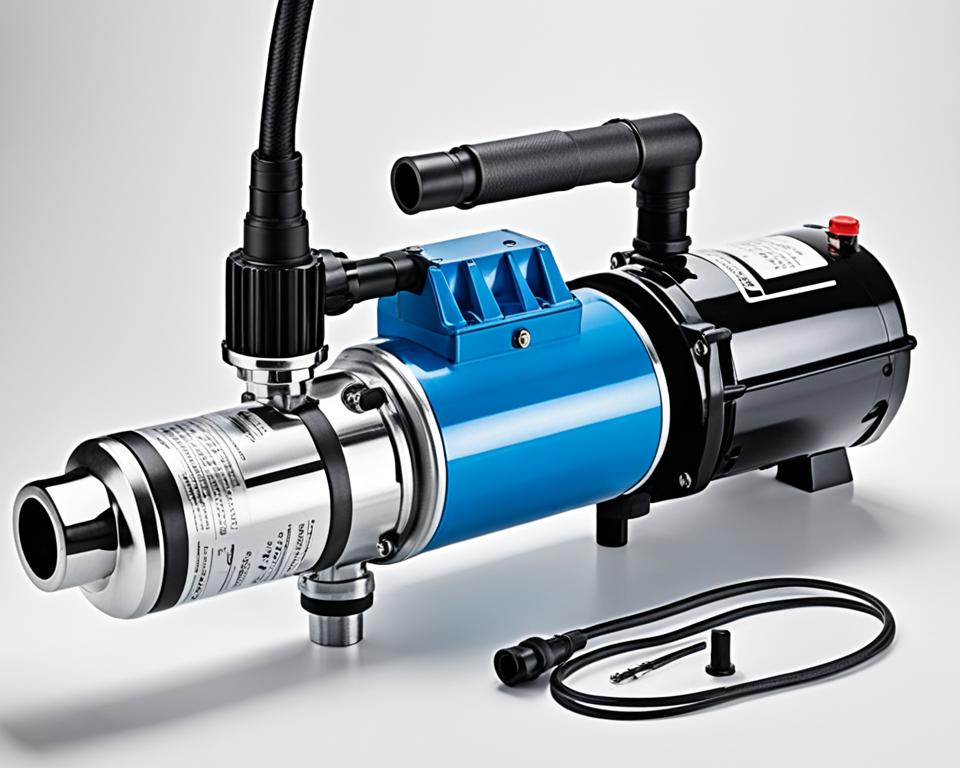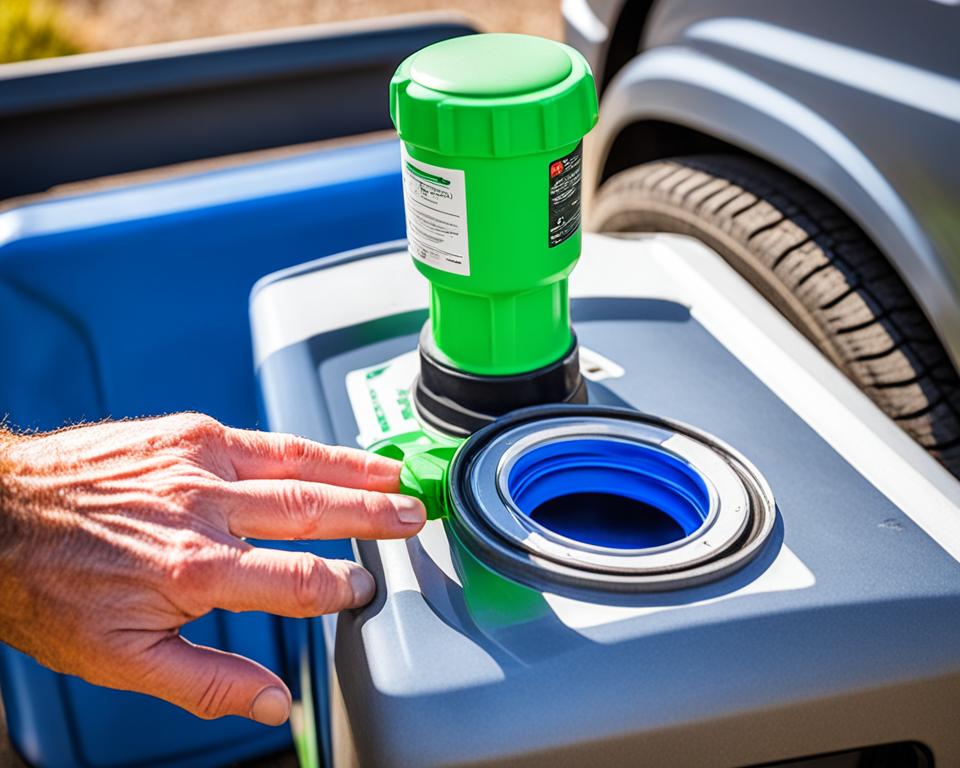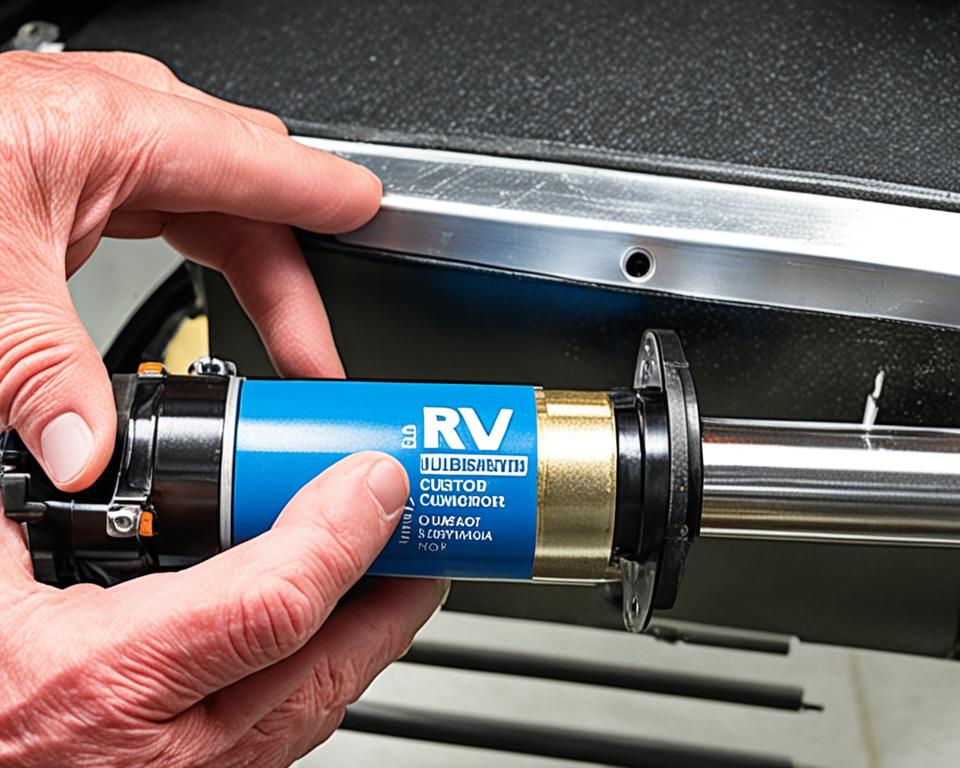Taking care of your RV is important for ensuring it lasts for years and years of camping fun. One of the most important appliances to keep in good shape is your air conditioning unit, meaning RV AC maintenance should definitely make its way onto your to-do list every 6 months or so. In this article, we will cover the top 5 things you should know about maintaining the air conditioner on your trailer or motorhome so you can ensure you stay nice and cool on all of your camping adventures.
Key Takeaways:
- Perform RV air conditioning unit maintenance every 6 months to keep it in good condition.
- Inspect the RV A/C cover regularly to protect the unit from damage.
- Check for A/C leaks and tighten screws to prevent water intrusion.
- Straighten AC fins and clean them periodically to ensure proper airflow.
- RV air conditioners cannot be recharged; seek appropriate repair options if issues arise.
Inspect the RV A/C Cover
The plastic shroud or cover that goes over the RV air conditioner is crucial for protecting the unit from dirt, debris, and other foreign objects. It also acts as a barrier against potential damage caused by low-hanging limbs or hail. Over time, these shrouds can suffer wear and tear from exposure to sunlight, low-hanging branches, or other objects. Therefore, regular inspections of the RV A/C cover are necessary to ensure it remains in good shape and capable of effectively safeguarding the air conditioner.
Inspecting the RV A/C cover a couple of times a year is highly recommended. During the inspection, carefully assess the condition of the cover, looking for any signs of damage or weakness. Pay particular attention to any cracks, holes, or areas of the cover that may have become loose or dislodged.
“Regular inspections of the RV A/C cover are necessary to ensure it remains in good shape and capable of effectively safeguarding the air conditioner.”
If you notice any damage or compromised areas, it’s essential to address the issue promptly. Neglecting damaged shrouds can expose your RV air conditioner to potential harm.
To protect your RV AC unit and prevent damage to the air conditioner, it’s advisable to:
- Replace cracked or broken covers with new ones
- Secure loose or dislodged sections of the cover
- Repair any holes or tears
By consistently inspecting and maintaining the RV A/C cover, you can ensure the long-lasting protection and optimal functioning of your RV air conditioner.
Check for A/C leaks
Water leaks can pose a significant problem for RV air conditioning units, leading to potential damage and costly repairs. To prevent water intrusion and maintain the longevity of your AC unit, it’s essential to regularly check for leaks and ensure the tightness of its components.
The RV air conditioner is typically set into a hole in the roof, secured by screws and a rubber ring seal to keep water out. Over time, the rubber seal can deteriorate or sustain damage, compromising its effectiveness and leading to potential leaks. Therefore, it’s crucial to inspect the seal every 6 months or as needed for any signs of wear or tear.
Additionally, tightening the screws that hold the AC unit in place can help maintain a tight and secure seal, preventing water from entering the RV. By giving the screws a gentle twist using a screwdriver or a wrench, you can ensure they are properly tightened and minimize the risk of leaks.
Regularly checking for A/C leaks and maintaining the water seal of your RV air conditioner is a simple yet crucial step in preventing water damage and ensuring optimal performance. By taking these preventive measures, you can enjoy worry-free camping trips and prolong the lifespan of your AC unit.
Key Points:
- Inspect the rubber ring seal of your RV air conditioner every 6 months or as needed to identify any signs of damage or wear.
- Tighten the screws that secure the AC unit to maintain a tight water seal and prevent leaks.
Straight fins are key
The metal fins on the RV air conditioner play a crucial role in its performance. Over time, these fins can become bent or accumulate debris, which can hinder airflow and reduce cooling efficiency. To maintain optimal performance, it is important to regularly straighten the fins and keep them clean.
Here are some steps to help you with RV air conditioner fin maintenance:
- Straightening the Fins: Using a fin comb, gently straighten any bent fins. This tool allows you to align the fins back to their original position, ensuring proper airflow. Be careful not to apply too much pressure, as the fins are delicate.
- Removing Debris: Dirt, leaves, and other debris can accumulate on the AC unit, obstructing airflow and reducing efficiency. To remove debris, use a vacuum cleaner with a brush attachment or a soft brush to gently clean the fins and other parts of the AC unit. This will help the air conditioner operate more effectively.
- Cleaning the Fins: If the fins are dirty or clogged, it is essential to clean them. Use a mild detergent or specialized fin cleaner and a soft brush to carefully scrub away any dirt or grime. Rinse the fins thoroughly with water to ensure all cleaning agents are removed.
Regular maintenance of the RV air conditioner fins should be performed every 6 months or as needed, especially before the summer season when the AC unit will be in high demand.
By keeping the fins straight and free of debris, you can ensure proper airflow and improve the overall efficiency of your RV air conditioner. A well-maintained AC unit will provide you with cool comfort on all your camping adventures.
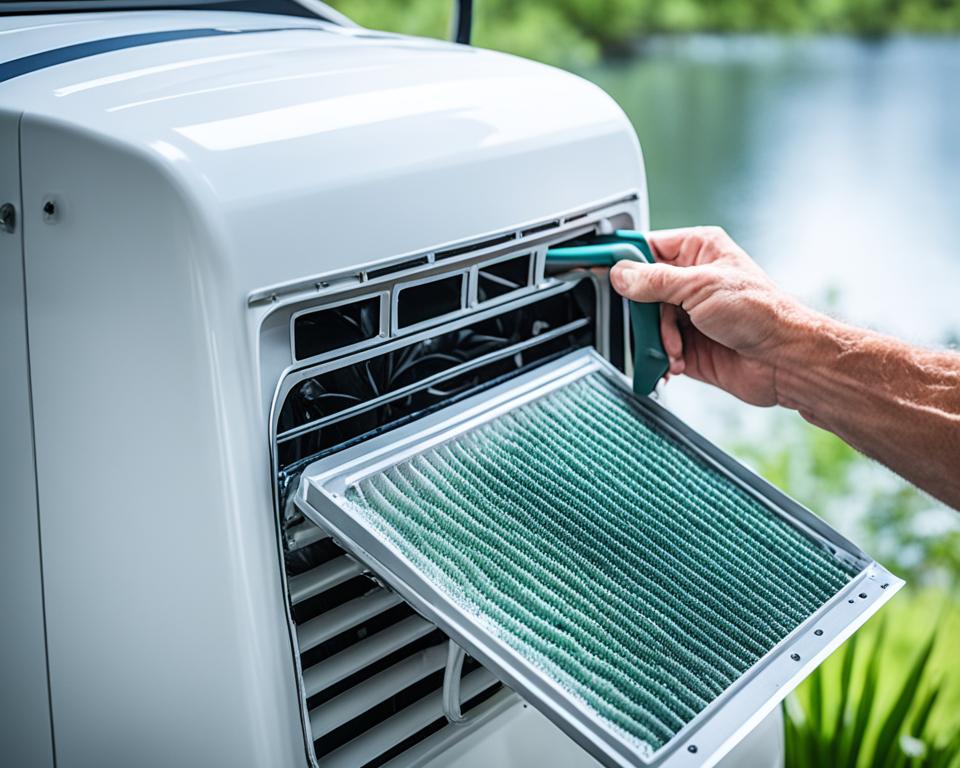
Recharging isn’t possible
When it comes to RV air conditioners, recharging is not an option like it is with house air conditioners. If you’re experiencing issues with your AC unit, attempting to recharge it won’t solve the problem. Instead, you’ll need to explore other troubleshooting steps to identify and fix the issue.
“Recharging the RV air conditioner is not a viable solution when it comes to addressing AC problems in your recreational vehicle,”
It’s crucial to understand this limitation and seek the appropriate repair options for your RV’s AC unit. By troubleshooting the problem correctly, you can address the root cause and restore the functionality of your air conditioner.
Troubleshooting RV AC Problems
When your RV air conditioner is malfunctioning, it’s important to take the following steps to troubleshoot the issue:
- Check the power supply: Ensure that the AC unit is receiving adequate power and that the electrical connections are secure.
- Inspect the thermostat: Verify that the thermostat is set correctly and functioning properly.
- Clean or replace the air filter: A dirty or clogged filter can restrict airflow and impact the performance of the AC unit.
- Examine the compressor: Inspect the compressor for any signs of damage or wear. If necessary, consult a professional for repair or replacement.
- Inspect the condenser coils: Check for any debris or dirt accumulation on the condenser coils and clean them if needed.
- Check for refrigerant leaks: Look for any signs of refrigerant leaks and repair them promptly to avoid further damage.
- Seek professional assistance: If the troubleshooting steps don’t resolve the issue, it’s recommended to consult an HVAC technician who specializes in RV air conditioner repair.
By following these troubleshooting steps, you can effectively address any problems with your RV air conditioner without relying on recharging as a solution.
| AC Unit Repair Options | Pros | Cons |
|---|---|---|
| DIY Repair | – Cost-effective – Immediate action |
– Lack of expertise – May void warranty |
| Professional Repair | – Knowledgeable experts – Warranty protection |
– Higher repair costs – Wait time for service |
| AC Unit Replacement | – Improved energy efficiency – Long-term solution |
– Higher upfront costs – Installation required |
While recharging is not an option for RV air conditioners, there are various repair options available to address any issues you may encounter. These options include:
- DIY Repair: If you have the necessary skills and knowledge, you can attempt to repair the AC unit yourself.
- Professional Repair: An experienced HVAC technician can diagnose and fix the problem, ensuring proper repair techniques and warranty protection.
- AC Unit Replacement: If your RV’s air conditioner is beyond repair or outdated, replacing it with a new unit may be the best option for improved efficiency and performance.
By understanding the limitations and exploring the appropriate repair options, you can effectively address any issues with your RV air conditioner and ensure optimal cooling during your camping adventures.
Filters can (and should) be washed
Cleaning and maintaining the air conditioner filter is an essential task that can greatly contribute to troubleshooting any AC issues. By ensuring the filter is clean and in good condition, you can optimize the performance of your RV air conditioner. Regular filter maintenance helps to maintain proper airflow and prevent the buildup of dirt and debris, ensuring your AC unit functions effectively.
Here are some simple steps to wash your RV air conditioner filter:
- Remove the filter from the AC unit.
- Rinse the filter under running water to remove loose dirt and debris.
- Fill a bucket with warm soapy water.
- Submerge the filter in the soapy water and gently agitate it to remove stubborn dirt and grime.
- Rinse the filter thoroughly to remove any soap residue.
- Allow the filter to dry completely in direct sunlight.
- Once dry, reinstall the filter back into the AC unit.
It is recommended to wash your RV air conditioner filter at least every six months, or more frequently if you use the AC unit regularly. Regular washing helps to maintain efficient cooling and prolong the life of your filter.
If your filter becomes excessively worn or damaged, it may be necessary to replace it. While it’s ideal to find a perfect fit for your RV air conditioner, it’s acceptable to purchase a larger filter and cut it down to size if needed. This ensures that you have a functional filter that efficiently removes airborne particles and maintains the air quality inside your RV.
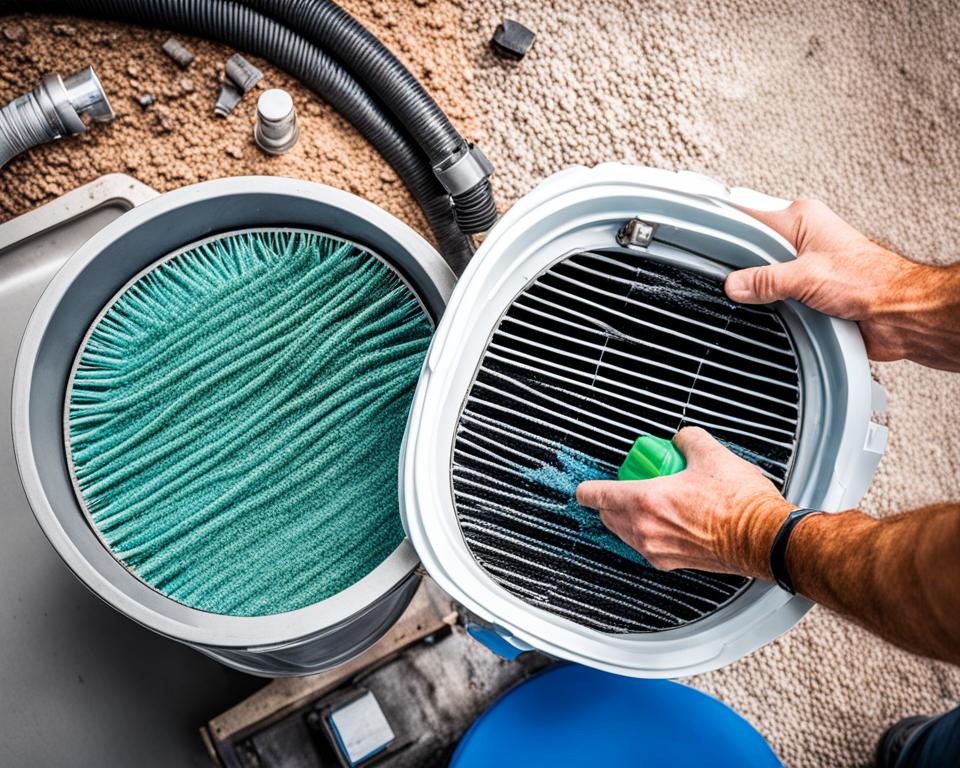
Proper maintenance of your RV air conditioner filter is a crucial aspect of keeping your AC unit running smoothly. By regularly washing and replacing the filter when necessary, you can improve airflow, enhance cooling efficiency, and ensure a comfortable and refreshing indoor environment during your RV adventures.
Ensure you have enough power
RV air conditioners require a significant amount of power to operate effectively, especially during startup. It’s important to ensure that you have an adequate power supply to prevent damage to the AC unit. Running the AC unit on a 15- or 20-amp outlet is discouraged, as it can lead to long-term damage. It’s important to have the proper power supply for your AC unit to ensure its longevity and efficiency.
| Power Supply | AC Unit Power Requirements |
|---|---|
| 30-Amp Outlet | Recommended power supply for optimal performance |
| 15-Amp Outlet | Insufficient power supply, leads to potential AC unit damage |
| 20-Amp Outlet | Insufficient power supply, leads to potential AC unit damage |
When it comes to RV air conditioner power requirements, it’s crucial to have the right electrical supply for your AC unit. Running your AC on a lower amp outlet can result in low power situations, which can damage the AC unit over time. Therefore, it’s recommended to always verify the power supply before using the AC unit.
Ensure your RV is equipped with a 30-amp outlet, which provides the necessary power for the air conditioner to run efficiently and avoid any potential damage. If your RV does not have a 30-amp outlet, consider upgrading your electrical system to accommodate the power requirements of the AC unit.
By providing the proper electrical supply for your AC unit, you’ll not only prevent damage but also ensure that your RV stays cool and comfortable during hot summer days. Don’t compromise on power and invest in the right infrastructure for your RV air conditioner.
Use a soft starter
If you need to run your RV air conditioner on a lower power supply or want to be able to run multiple AC units on limited power, installing a soft starter can be beneficial. A soft starter reduces the amount of power needed to start the AC unit, protecting it from potential damage caused by low power situations.
One popular brand of RV AC soft starters is SoftStartRV, which allows for running multiple AC units on just 30 amps of power. By using a soft starter, you can ensure that your AC unit operates efficiently and smoothly, even with limited power.
Installing a soft starter not only helps reduce the AC startup power requirements but also provides added protection to your AC unit, extending its lifespan and improving its performance. It’s a cost-effective solution that allows you to enjoy the comfort of your RV’s air conditioning system without worrying about power limitations.
Advantages of Using a Soft Starter:
- Reduces AC startup power requirements
- Protects the AC unit from damage due to low power
- Allows for running multiple AC units on limited power
- Prolongs the lifespan of the AC unit
- Improves AC unit performance and efficiency
How Soft Starters Work:
Soft starters work by gradually increasing the voltage and current supplied to the AC unit during startup. This gradual increase prevents the unit from drawing excessive power all at once, reducing the strain on the electrical system. As a result, the AC unit starts up smoothly and operates more efficiently.
| Traditional AC Startup | AC Startup with Soft Starter |
|---|---|
| High power demand during startup | Reduced power demand during startup |
| Potential strain on the electrical system | Less strain on the electrical system |
| Increased risk of tripping breakers | Reduced risk of tripping breakers |
By using a soft starter, you can enjoy the benefits of running your RV air conditioner without worrying about power limitations. It’s an investment that not only protects your AC unit but also enhances your overall camping experience by ensuring a comfortable and cool environment inside your RV.
Track your maintenance
Keeping track of your RV air conditioner maintenance is crucial to ensure that regular inspections and cleaning are performed. This helps in maintaining the optimal performance of your RV air conditioner. By using an online tool like RV LIFE Maintenance, you can conveniently track all your maintenance tasks in one place.
RV LIFE Maintenance provides a user-friendly platform to record and monitor your RV air conditioner maintenance. It allows you to create a personalized maintenance schedule, set reminders, and keep track of completed tasks. You can also easily access your maintenance records whenever needed.
By utilizing RV LIFE Maintenance, you can avoid the hassle of manual record-keeping and stay organized with your RV air conditioner maintenance. It sends convenient email reminders when maintenance is due, ensuring that you never miss an important check-up for your AC unit.
With RV LIFE Maintenance, you can:
- Track the date of your last maintenance
- Record details of the performed maintenance tasks
- Set reminders for future maintenance
- Access a comprehensive maintenance history
Using this tool simplifies the process of RV air conditioner maintenance tracking, helping you stay on top of your AC unit’s care requirements. It provides peace of mind, knowing that you are proactively maintaining your RV air conditioner and reducing the risk of costly repairs due to neglect.
In addition, keeping accurate maintenance records can also increase the resale value of your RV. Prospective buyers will appreciate the well-documented history of regular maintenance and care, making your RV more attractive in the market.
Don’t leave your RV air conditioner maintenance to chance. Take advantage of the convenience and effectiveness of RV LIFE Maintenance to ensure your AC unit remains in excellent condition for all your future camping adventures.
| Maintenance Tracking Benefits |
|---|
| Efficient organization of RV air conditioner maintenance tasks |
| Convenient email reminders for timely maintenance |
| Easy access to maintenance records |
| Increased resale value of your RV |
Conclusion
Taking care of your RV air conditioning unit is essential for ensuring it functions properly and provides optimal cooling during your camping adventures. Regular maintenance is key to keeping your AC unit in top shape. By inspecting the cover, checking for leaks, straightening fins, and cleaning or replacing filters every 6 months or as needed, you can prevent potential issues and maximize the efficiency of your AC unit.
Additionally, it’s important to ensure you have enough power for your AC unit to operate effectively. Using a soft starter can help reduce the power requirements and protect your AC unit. Consider installing a soft starter, like the popular brand SoftStartRV, to improve the efficiency of your AC unit, especially if you need to run multiple AC units on limited power.
To stay organized and on top of your RV air conditioner maintenance, consider using tools like RV LIFE Maintenance. This online tool allows you to track all of your maintenance tasks, set reminders, and keep accurate records. By following these quick tips and utilizing RV maintenance tools, you can enjoy a comfortable and cool camping experience in your RV, knowing that your AC unit is in good condition and ready to keep you cool on your adventures.
FAQ
How often should I inspect the RV A/C cover?
It’s important to inspect the RV A/C cover a couple of times a year to ensure it’s still in good shape and able to do its job.
How can I prevent water leaks in my RV air conditioner?
Check the rubber ring seal and tighten the screws that hold the AC unit in place every 6 months to prevent water intrusion and damage.
What should I do to maintain the metal fins of my RV air conditioner?
Use a comb to carefully straighten any bent fins and a vacuum to remove dirt every 6 months to ensure proper airflow and optimal AC unit performance.
Can I recharge my RV air conditioner?
No, RV air conditioners cannot be recharged. If there are issues with the AC unit, recharging is not a solution. Other troubleshooting steps should be taken to identify and fix the problem.
How often should I clean and maintain the air conditioner filter?
The air conditioner filter should be washed in warm soapy water and set in the sun to dry at least every six months or more frequently if the AC unit is used regularly. Eventually, the filter may need to be replaced if it becomes too worn.
What should I do to ensure I have enough power for my RV air conditioner?
Avoid running the AC unit on a 15- or 20-amp outlet as it can lead to long-term damage. It’s important to have the proper power supply for your AC unit to ensure its longevity and efficiency.
What is a soft starter and how can it benefit my RV air conditioner?
A soft starter reduces the amount of power needed to start the AC unit, preventing damage from low power situations. Installing a soft starter can help protect your AC unit and ensure it operates efficiently.
How can I track the maintenance of my RV air conditioner?
You can use online tools like RV LIFE Maintenance to track all of your maintenance tasks in one place. This tool provides reminders via email when maintenance is due, helping you avoid costly repairs due to neglect.
Why is taking care of my RV air conditioning unit important?
Taking care of your RV air conditioning unit is essential for ensuring it functions properly and provides optimal cooling during your camping adventures. Regular maintenance and inspections are necessary to keep the unit in good shape and prevent damage.
What are the key takeaways for RV air conditioner upkeep?
Regularly inspect and maintain the RV A/C cover, check for water leaks, straighten the metal fins, clean or replace the filter, ensure sufficient power supply, consider using a soft starter, and track your maintenance for optimal RV air conditioning unit care.

